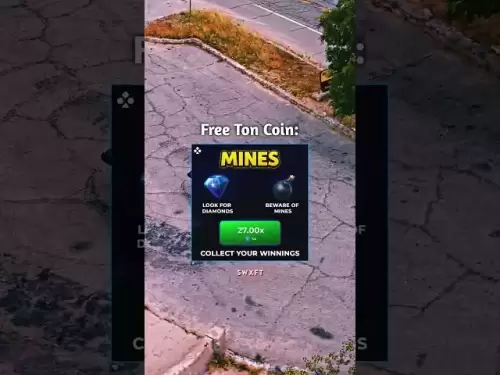-
 Bitcoin
Bitcoin $118100
-0.86% -
 Ethereum
Ethereum $3787
-1.64% -
 XRP
XRP $3.133
-2.92% -
 Tether USDt
Tether USDt $0.9999
-0.03% -
 BNB
BNB $833.2
-1.19% -
 Solana
Solana $183.5
-2.38% -
 USDC
USDC $0.9997
-0.01% -
 Dogecoin
Dogecoin $0.2266
-4.99% -
 TRON
TRON $0.3236
1.25% -
 Cardano
Cardano $0.7943
-3.74% -
 Hyperliquid
Hyperliquid $43.93
0.66% -
 Sui
Sui $3.951
-8.38% -
 Stellar
Stellar $0.4202
-4.58% -
 Chainlink
Chainlink $18.17
-4.24% -
 Bitcoin Cash
Bitcoin Cash $583.1
-1.67% -
 Hedera
Hedera $0.2696
-5.46% -
 Avalanche
Avalanche $24.99
-3.22% -
 Litecoin
Litecoin $109.3
-4.19% -
 UNUS SED LEO
UNUS SED LEO $8.973
0.13% -
 Toncoin
Toncoin $3.240
-4.14% -
 Shiba Inu
Shiba Inu $0.00001341
-4.15% -
 Ethena USDe
Ethena USDe $1.001
-0.03% -
 Uniswap
Uniswap $10.50
-3.00% -
 Polkadot
Polkadot $3.977
-5.08% -
 Monero
Monero $319.4
-1.05% -
 Dai
Dai $0.9998
0.00% -
 Bitget Token
Bitget Token $4.584
-2.51% -
 Pepe
Pepe $0.00001193
-5.58% -
 Cronos
Cronos $0.1395
-2.41% -
 Aave
Aave $289.6
-4.05%
What is a mining pool? Can joining a mining pool increase mining income?
Joining a mining pool can increase income through more frequent rewards and lower operational costs, but choosing the right pool is crucial for maximizing earnings.
May 12, 2025 at 12:35 am

A mining pool is a collaborative group of cryptocurrency miners who combine their computational resources to increase their chances of solving complex mathematical problems and earning mining rewards. By working together, miners in a pool can share the rewards more consistently rather than relying on the luck of solo mining. The concept of mining pools became prominent with the rise of Bitcoin and other cryptocurrencies that use proof-of-work consensus mechanisms.
How Mining Pools Work
Mining pools operate by distributing the workload across a network of miners. When a pool successfully mines a block, the reward is divided among the participants according to their contributed computational power. This distribution is often managed by a pool operator who maintains the infrastructure and charges a fee for the service.
- Joining a Pool: Miners can join a pool by connecting their mining hardware to the pool's server. This usually involves configuring the mining software to point to the pool's address and setting up a wallet to receive payouts.
- Contribution and Rewards: Each miner's contribution is measured in terms of the hash rate they provide to the pool. The more hash power a miner contributes, the larger their share of the reward will be.
- Pool Fees: Most pools charge a fee, typically ranging from 1% to 3%, to cover operational costs and profit for the pool operator.
Benefits of Joining a Mining Pool
Joining a mining pool can offer several advantages for miners looking to increase their income and stabilize their earnings.
- Increased Probability of Rewards: By pooling resources, miners can solve blocks more frequently than they would on their own. This increases the likelihood of earning rewards on a regular basis.
- Consistent Income: Solo mining can be highly unpredictable, with long periods of no rewards followed by large payouts. Mining pools offer a more predictable income stream, as rewards are distributed more evenly among participants.
- Reduced Variance: The variance in mining rewards is significantly reduced when mining in a pool. This means miners can better plan their finances without the uncertainty of solo mining.
Can Joining a Mining Pool Increase Mining Income?
Joining a mining pool can indeed increase mining income in several ways, but it's important to understand the dynamics at play.
- Higher Frequency of Rewards: As mentioned, pools increase the frequency of mining rewards. While the individual reward per block might be smaller, the overall income can be higher due to more consistent payouts.
- Economies of Scale: Larger pools can negotiate better fees with mining hardware manufacturers and electricity providers, potentially lowering operational costs for miners.
- Access to Advanced Features: Many pools offer advanced features such as merged mining, which allows miners to mine multiple cryptocurrencies simultaneously, potentially increasing overall income.
Factors to Consider When Choosing a Mining Pool
Selecting the right mining pool is crucial for maximizing income and ensuring a positive mining experience. Here are some key factors to consider:
- Pool Size and Hash Rate: Larger pools with higher hash rates tend to find blocks more frequently, but they also have more miners to share rewards with. Smaller pools may offer larger individual payouts but with less frequency.
- Fees and Payout Structure: Compare the fees charged by different pools and their payout structures. Some pools offer a pay-per-share (PPS) model, while others use a proportional or score-based system.
- Pool Reputation and Reliability: Research the reputation of the pool and read reviews from other miners. A reliable pool with good customer support can make a significant difference in your mining experience.
- Security and Transparency: Ensure the pool has robust security measures in place and provides transparent reporting of its operations and finances.
Setting Up to Join a Mining Pool
Joining a mining pool involves several steps that require careful attention to detail. Here's a guide to get you started:
- Choose a Pool: Research and select a mining pool that aligns with your needs and preferences.
- Set Up a Wallet: You'll need a cryptocurrency wallet to receive your mining rewards. Make sure it supports the cryptocurrency you're mining.
- Configure Mining Software: Download and install mining software compatible with your hardware. Popular options include CGMiner, EasyMiner, and MultiMiner.
- Connect to the Pool: Configure your mining software to connect to the pool's server. This typically involves entering the pool's URL, your username, and a password or worker name.
- Start Mining: Once configured, start your mining software and monitor its performance. Ensure your hardware is running efficiently and that you're receiving regular updates from the pool.
Monitoring and Optimizing Your Mining Pool Experience
After joining a mining pool, it's essential to monitor your performance and make adjustments to optimize your income.
- Track Your Earnings: Regularly check your earnings and compare them to your operational costs. Many pools offer detailed dashboards to help you monitor your performance.
- Adjust Your Setup: If you find that your income is not meeting your expectations, consider adjusting your setup. This could involve upgrading your hardware, switching pools, or optimizing your mining software settings.
- Stay Informed: Keep up-to-date with changes in the cryptocurrency market and any updates from your mining pool. Being informed can help you make better decisions to maximize your income.
Frequently Asked Questions
Q: Can I join multiple mining pools at the same time?
A: Yes, it is possible to join multiple mining pools simultaneously. This can help diversify your mining efforts and potentially increase your overall income. However, you'll need to manage multiple setups and ensure that your hardware can handle the additional workload.
Q: How do mining pools ensure fair distribution of rewards?
A: Mining pools use various methods to ensure fair distribution of rewards. Most commonly, they track each miner's contribution in terms of hash power and allocate rewards proportionally. Some pools also use scoring systems or pay-per-share models to ensure fairness.
Q: What happens if a mining pool goes offline?
A: If a mining pool goes offline, miners connected to that pool will temporarily stop earning rewards. It's important to choose a reliable pool with a good track record of uptime. If a pool goes offline frequently, it may be worth considering switching to a more stable option.
Q: Are there any risks associated with joining a mining pool?
A: While mining pools can increase your chances of earning rewards, there are some risks to consider. These include pool fees, the potential for the pool to go offline, and the risk of the pool operator engaging in fraudulent activities. Always research a pool's reputation and security measures before joining.
Disclaimer:info@kdj.com
The information provided is not trading advice. kdj.com does not assume any responsibility for any investments made based on the information provided in this article. Cryptocurrencies are highly volatile and it is highly recommended that you invest with caution after thorough research!
If you believe that the content used on this website infringes your copyright, please contact us immediately (info@kdj.com) and we will delete it promptly.
- Avalanche (AVAX) Price Pump Incoming? Analysts Weigh In
- 2025-07-29 06:50:12
- Presales, Investment, July 2025: What's Hot and What's Not
- 2025-07-29 06:30:12
- PayPal, Bitcoin, and Merchants: A New Era of Commerce?
- 2025-07-29 07:10:13
- RUVI Token's Ripple Rally Potential: Audited AI Crypto Heats Up!
- 2025-07-29 04:50:12
- ADA Price, Cardano, SUI & Remittix: Decoding the Latest Crypto Moves
- 2025-07-29 04:50:12
- Solana, ARK Invest, and Staking: A New Era of Institutional Crypto?
- 2025-07-29 05:30:12
Related knowledge

What was the highest APY for IRON mining?
Jul 23,2025 at 05:14am
Understanding IRON Token and Its Mining MechanismThe IRON token is a stablecoin that operates within the Iron Finance ecosystem, primarily on blockcha...

What is impermanent loss in IRON pools?
Jul 23,2025 at 09:00am
Understanding Impermanent Loss in the Context of IRON PoolsImpermanent loss is a phenomenon that affects liquidity providers in decentralized finance ...

How to claim rewards from IRON mining?
Jul 23,2025 at 02:21pm
Understanding IRON Mining and Reward MechanismsIRON Finance operated as a decentralized finance (DeFi) protocol on the Polygon and Binance Smart Chain...

How to claim rewards from IRON mining?
Jul 29,2025 at 05:07am
Understanding IRON Mining and Reward MechanismIRON is a dual-token system designed to stabilize the value of a synthetic asset through a combination o...

IRON mining tutorial for beginners
Jul 27,2025 at 12:01am
What Is IRON and How Does It Work in the Cryptocurrency Ecosystem?IRON is a cryptocurrency token that operates on the Binance Smart Chain (BSC) and is...

How to calculate APY for IRON mining?
Jul 28,2025 at 09:49am
Understanding APY in the Context of IRON Token MiningWhen engaging in IRON token mining within decentralized finance (DeFi) platforms, Annual Percenta...

What was the highest APY for IRON mining?
Jul 23,2025 at 05:14am
Understanding IRON Token and Its Mining MechanismThe IRON token is a stablecoin that operates within the Iron Finance ecosystem, primarily on blockcha...

What is impermanent loss in IRON pools?
Jul 23,2025 at 09:00am
Understanding Impermanent Loss in the Context of IRON PoolsImpermanent loss is a phenomenon that affects liquidity providers in decentralized finance ...

How to claim rewards from IRON mining?
Jul 23,2025 at 02:21pm
Understanding IRON Mining and Reward MechanismsIRON Finance operated as a decentralized finance (DeFi) protocol on the Polygon and Binance Smart Chain...

How to claim rewards from IRON mining?
Jul 29,2025 at 05:07am
Understanding IRON Mining and Reward MechanismIRON is a dual-token system designed to stabilize the value of a synthetic asset through a combination o...

IRON mining tutorial for beginners
Jul 27,2025 at 12:01am
What Is IRON and How Does It Work in the Cryptocurrency Ecosystem?IRON is a cryptocurrency token that operates on the Binance Smart Chain (BSC) and is...

How to calculate APY for IRON mining?
Jul 28,2025 at 09:49am
Understanding APY in the Context of IRON Token MiningWhen engaging in IRON token mining within decentralized finance (DeFi) platforms, Annual Percenta...
See all articles

























































































